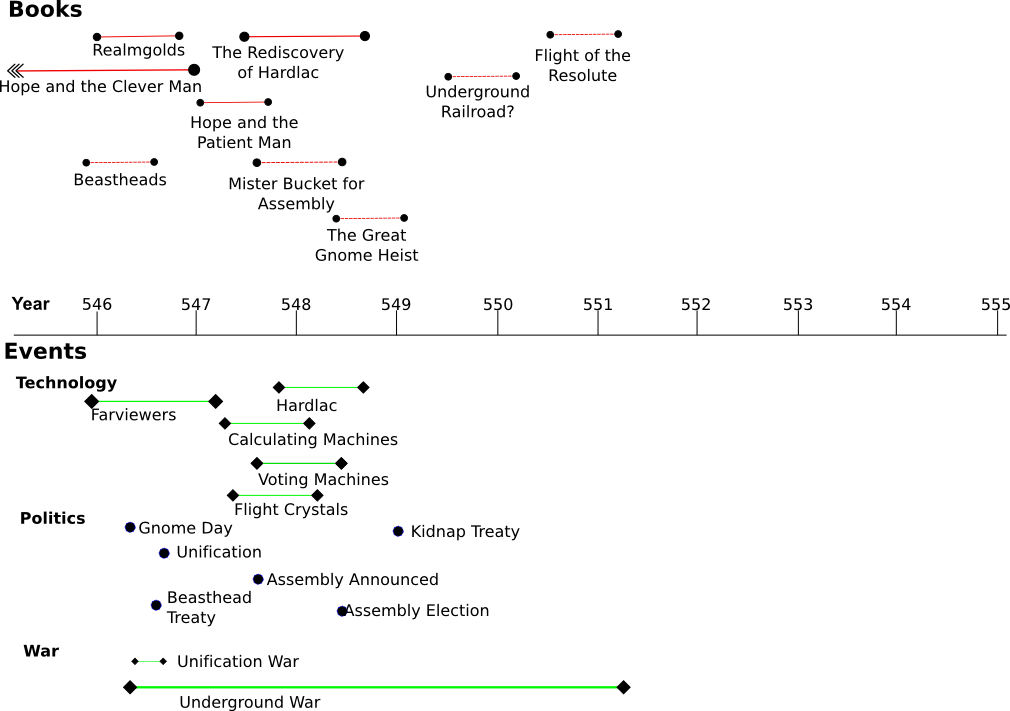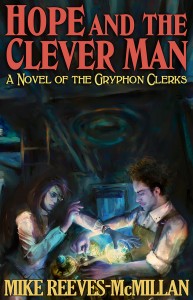As I write, the latest Gryphon Clerks novel, Hope and the Clever Man, is on a Kindle Countdown Deal over at Amazon. That means it starts out at 99c and goes up by a dollar every couple of days until it’s back at $4.99. The sooner you get over there, the better the deal, if you don’t have it already. (Realmgolds is still on sale at half price, too.)
I’m using some of my holiday time to work on the sequel, Hope and the Patient Man, so I thought I’d give you an excerpt from Chapter 1. To find out how these two characters get together, and how Hope got herself cursed, of course, you’ll need to read Hope and the Clever Man.
—————————————
They’d had a delicious dinner at one of the more expensive Gulfport restaurants, and shared a bottle of excellent wine. Judging by the way Hope was walking, it was more wine than she usually indulged in. She took Patient’s right arm and stumbled against him, laughing.
“Careful,” he said, flinging out his walking stick to keep himself from falling, and mentally cursing his weak leg. The carved dragon head of his stick dug into his hand as he used it to lever his weight, and Hope’s, to the right.
“Sorry. It’s these shoes.” Her own footwear mostly had steel toes, so she had borrowed a pair of shoes for the evening from her best friend and flatmate Briar.
“I thought it was the wine.”
“And the wine. Shoes and wine, Briar’s two favourite things. What are your favourite things, Patient?” She laughed again. He would almost say she giggled, except that Hope didn’t giggle. Her large dark eyes met his with an unguardedness that he hadn’t seen before. Pale as she was from working indoors, her flushed cheeks brought her back to a more usual skin tone, and her black hair, gleaming and herb-scented, fell across one side of her face. She blew it away and laughed again, and his heart contracted sharply. He was still not used to the idea that such a beautiful woman wanted to spend time with him.
“I don’t think you should get on that airhorse,” he said.
“No? You’re probably right. But how’m I going to get home?” She stretched out the last word, crooning it.
“You could stay in town here and go home in the morning. Probably not much more expensive than a ferry back to Illene, then a ferry back here again to get the airhorse.”
“And how’re you going to get home?”
“I could take the ferry, I suppose, and walk.” Patient’s home in Redbridge, a village not far north of Gulfport, lay near the river that also ran through the city and through the university town of Illene, where Hope lived. Even with his leg, he could walk between the ferry dock and his cottage without much discomfort.
“Or you could stay in town too. Should we get one room, or two?”
“Now I know you’re drunk. Which means that the answer’s two.”
“Oh, come on,” she said playfully, and swung around in front of him on the pavement, seizing both his forearms. “We’ve had a nice night. Let’s live a little.” She slid her hands up his arms to the shoulders, stepped in, and raised her face to his. Startled, he let the kiss begin.
She screamed, convulsed, and collapsed. He staggered as he grabbed for her, trying to keep her from falling, but his weak leg folded under him and they both stumbled to the ground. Her head struck the stone kerb and rebounded.
“Hope!” he shouted. She was whimpering and twitching in some kind of fit.
He heard running footsteps from behind him as he tried to keep her head from impacting the hard surface a second time. They hadn’t walked far from the restaurant, less than a block, and he recognised the doorman as the man leaned over them.
“What is it?” he asked. “What’s wrong?”
“Not sure,” said Patient. “Some kind of fit. Help me get her safe, put…” but the doorman was already whipping off his jacket and wadding it up to put under her head. They got her stretched out and waited for the fit to be over, Patient pulling himself round to sit with her head in his lap while the doorman crouched next to her shoulder. Patient’s leg had woken up and was proclaiming its tale of woe, but he ignored it.
After what seemed like much longer than it probably was, Hope gave a gasp and her eyes came back into focus. She made gagging movements, and he rolled her quickly onto her side, whereupon she threw up a gourmet meal and half a bottle of expensive wine onto his new trousers.
When the vomiting was over and her breathing had settled down, she tried to get up, and he helped her as best he could. The doorman was more help; he had leverage, and heaved Hope to her feet.
“Are you all right, Mage?” he asked. The silver bracelet on her left wrist, proclaiming her status as a full mage, glittered under the street lights, and the gems set in it sparkled. She nodded mutely, clutching her head.
Patient had reclaimed his stick, and was trying to regain his feet. He nearly slipped in the puddle of vomit before the doorman, still propping Hope up with one arm, heaved him upright with the other.
“Thanks,” he said, trying to ignore the unpleasant dampness seeping through his trouser leg.
“Sorry,” said a still drunk-sounding Hope. She gently disengaged from the doorman and stood, a little shakily, on her own feet.
“What was that?” he asked.
“Oathconflict, I think,” she said. “Curse it.” Her voice came out toneless and dull, unlike her usual rich mezzo.
“Well, I think that answers the question of whether you go home tonight,” he said. “The answer’s no. Where can we find a hotel?” he asked the doorman.
“Just round the corner,” said the man. “You want me to walk with you?”
“Stone?” called a man’s voice from behind them. “Everything all right?”
“The lady and gentleman had a fall,” the doorman called back. “I’m just going to take them round to the Peerless. Can you watch the door?”
“All right,” called the voice.
“The Peerless?” said Patient, a little nervously. “That sounds expensive.” The doorman looked puzzled, as far as Patient could tell under the dim lighting, and rightly so. The restaurant they had just come out of was hardly Fat Berry’s Fry Shack, and if you could afford to eat there, you could afford to stay at the Peerless. He thought of explaining that their meal had been paid for by Realmgold Victory.
“Don’t worry about it,” said Hope in a shaky voice. “I can cover it.”
Patient opened his mouth to argue, decided that it wasn’t the time, and shut it again. He and the doorman began to help her down the street, one on each side. She walked like a woman with three times her not-quite-24 years, but they turned the corner at last, and Stone the doorman called to his counterpart at the front of the Peerless.
“Hey, Willing! Come and give us a hand, mate.”
The other doorman hurried over, and helped Hope into the reception area, where another uniformed hotel employee bustled round the desk in concern.
“Should I send for a healer?” she asked.
“If you would,” said Patient quickly, before Hope could say no. Not that she looked as if she was going to. She even shot him a look of thanks.
The receptionist rousted out a youth from the room behind the desk and sent him on the errand, while the two doormen seated Hope in a chair in the lobby.
“Thank you, Mister… Stone, is it?” said Patient to the restaurant doorman.
“My pleasure to assist, sir,” said the man. Patient dug in his pocket and found some coins. He gave him the two biggest pieces, equivalent to a quarter of a silver hammer, and Stone seemed happy enough.
“I hope your lady’s all right, sir,” he said, and ran off to resume his duties round the corner.
“Sir, would you like us to assist you with your trousers?” said the hotel doorman. The receptionist was fussing over Hope.
“Eh? Oh, yes, thank you,” he said. “And we’ll need a room. Um, two rooms. No, better make it one room. I don’t want to leave her unwatched.”
“Are you all right yourself, sir?”
“Yes, yes, fine,” he said. “An existing injury.”
“In the war, sir?” said the doorman. Patient looked up and caught a look that combined respect and pity.
“Yes,” he said shortly. “As it happens. How far does the healer have to come?”
“Not far, sir, there’s a healer just two blocks over, and he’s contracted to the hotel. Did the lady have something that disagreed with her?”
There was a distinct tang of wine in among the vomit, and the doorman was clearly being tactful.
“More than that, I think,” said Patient. “She’s a mage, and she was involved in a kind of magical incident some years ago that has left her with… I suppose you’d say a curse. It got triggered.” His tone was curt, partly with worry for Hope, but mainly because it was none of the man’s wretched business.
“Ah,” said the doorman. “Well, sir, if you’re all right I’ll go and watch for the healer, shall I?”
“Please.”
With the doorman gone, Patient limped over to the chair and carefully lowered himself to one of the arms, trying to keep his spattered trouserleg well clear. “How are you doing?” he asked, while going through a checklist in his mind. As a former part-time village warden, he had been trained to deal with emergencies, and he was trying to remember what you did for someone who’d just had a fit.
“Thirsty,” she said.
“I’ll get…” began the receptionist.
“Let’s wait for the healer,” he said. “I don’t think we should give her anything until he gets here.”
Before either woman could argue, brisk boot-heels rang on the marble of the foyer, and the healer arrived, the round hat of his profession askew and his coat and trousers pulled on over a nightshirt. The boy entered in his wake, and the receptionist made a curt gesture sending him back to his lurking place behind the desk, while hovering herself.
The healer knelt and took Hope’s wrist, reading the state of her body while asking, “What’s happened here, then?” in a calm professional voice.
Patient fell into the rhythms of an incident report, giving an unemotional summary of events. He included the fact that Hope had had an oathconflict reaction, though he didn’t go into the background. He wondered if he should, because not doing so risked the implication that she was oathbound to someone else and seeing him behind her oathmate’s back, but decided that it was nobody else’s business and he didn’t care what they thought. The healer, who hadn’t previously looked at him, shot him a sharp glance, flicked his gaze briefly at the stick, and nodded, without apparent hostility. He touched the side of Hope’s head where it had met the stone kerb. The skin was unbroken, but reddened, and she winced away. He closed his eyes to concentrate, sensing underneath the skin.
“There’s a bit of bleeding under there,” he noted. “Not a lot, but enough to be of concern. Merriment,” he called to the receptionist, “send your boy for a cab, will you? We need to get her into the healing house overnight.”
“Oh,” said Patient.
“Sorry, sir,” said the healer. “Not something to take lightly, a head injury. I’d deal with it myself if it was most other things, but head trauma wants a specialist. I’m afraid your evening is rather ruined.”
Patient smiled grimly. “Thank you,” he said.
While they waited for the cab to come, he leaned down awkwardly next to Hope. “I hate to mention this,” he said, “but I don’t have enough money to tip all these nice people, pay the healer, and pay the cab.”
She fished out a purse and handed it over.
“Thank you,” he said again, and circulated, handing over money to the boy, the receptionist, the healer (rather a larger amount) and the doorman.
“Oh! Your trousers, sir,” said the receptionist. “The cabbie won’t let you in like that, I’m afraid, or he’ll charge you extra. I’ll see if I can find you a pair. What’s your waist size?”
Patient told her, and by the time the cab arrived he was in a pair of the hotel’s uniform trousers which were attempting to cut him in half, the closest pair the receptionist had been able to find, and she had taken his away to be cleaned. He made arrangements to pick them up next day and slipped her more copper.
He had never, he reflected, spent so much money on what was supposed to be a free evening, a reward for Hope from the Realmgold for working so hard last year. He returned to her side in time to help her to the cab. The cabbie looked at him oddly when he got in, with his stick and his too-small trousers, and again when he paid from Hope’s obviously feminine purse, but he was well beyond caring. He had fallen into the mentally distanced state that they taught in the military and that he had held onto through much of the war — especially the part after his injury. It allowed him to move on to the next thing that needed doing, and put off anger, fear and frustration until later.
The night staff at the healing house were quietly efficient, and a young healer came and sat beside Hope in one of the tiny treatment rooms, using her gift of Invisible Touch to stop the bleeding inside Hope’s head and ease the pressure. Patient leaned against the wall, giving them as much space as he could manage. He shifted his stick uncomfortably, trying to ease his throbbing leg.
“All right,” said the healer eventually. “I’ve done as much as I can for now. Let’s get you to bed.” Patient helped Hope walk along the gleamingly clean corridor in the impractical shoes. They helped her to a washroom to clean up, and Patient stood outside while the healer helped her change into a nightgown, then returned to assist with getting her into bed. She looked grey and exhausted.
“I’m going to give you the Healer’s Sleep now,” said the young woman, and worked a spell with the confidence of someone who performed it multiple times a day. Hope’s strained face relaxed as her eyes closed, her breathing deepened, and she fell into a deep sleep almost instantly.
“That should hold her until well into tomorrow morning,” said the healer. “You’re her… what? Oathmate?” She glanced at their hands, obviously checking for rings and, of course, not finding any. “Promised?” she amended.
“No.”
“You’re courting, then?”
“I’m her… friend,” he said. This, at least, was true. He wasn’t sure what else they were.
“Would you mind staying the night with her?”
“I’ll insist on it.”
“All right, let’s set you up with a pallet. You’re injured?”
“I got a knock to my bad leg,” he said, “but nothing new.”
“Let me take a look.” She sat him down in the corner and ran her hand over his leg above the borrowed trousers, eyes closed.
“That’s been well cared for, considering what a nasty injury it must have been originally,” she said. “Was it the war?”
“Yes,” he said, in the tone he used to discourage people asking anything more.
“How’s this?” she said, and he felt the cramped muscles relax and the damaged flesh flooding with warmth, as if he was in one of the herbal baths his local healer made him take. His pain eased.
“Oh, that’s helping,” he said.
“Good. I’ll send someone in to do your pallet. Do you think you can get to sleep?”
“Yes, I should be all right.”
“Good. I don’t want to give you the Sleep, because having you in here with her and able to wake up is an extra safety measure. Not that I think anything will happen overnight, but just in case. Someone will be with you very soon.”
Of course, with the best of intentions, it was actually some time before one of the healers’ assistants came in with a pallet for him, and he was able to take off the terrible trousers and fall onto it. Whereupon he lay awake late into the night, listening for any shift in Hope’s breathing.
She was still breathing steadily when he finally drifted off in the deep hours of the early morning.








